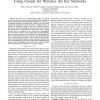Free Online Productivity Tools
i2Speak
i2Symbol
i2OCR
iTex2Img
iWeb2Print
iWeb2Shot
i2Type
iPdf2Split
iPdf2Merge
i2Bopomofo
i2Arabic
i2Style
i2Image
i2PDF
iLatex2Rtf
Sci2ools
ISCC
2009
IEEE
2009
IEEE
SECLOUD: Source and Destination Seclusion Using Clouds for wireless ad hoc networks
—The privacy of communicating entities in wireless ad hoc networks is extremely important due to the potential of their being identified and subsequently subjected to attacks (e.g., in military networks). Previously, the random walk and fractal propagation schemes have been proposed to address privacy of source and destination nodes in ad hoc or sensor networks. Entropy of packet transmissions has been used as the metric for comparison. In this paper, we show that under a global attacker that can eavesdrop on the overall data transmissions and count them, neither of these approaches provide sufficient privacy when the attacker can visualize the transmissions and infer contextual information. Moreover, we show that the entropy is not a useful metric in such a case. We propose SECLOUD: Source and Destination Seclusion using Clouds to obfuscate the true source/destination nodes and make them indistinguishable among a group of neighbor nodes which works well even under network-wide tra...
| Added | 21 May 2010 |
| Updated | 21 May 2010 |
| Type | Conference |
| Year | 2009 |
| Where | ISCC |
| Authors | Razvi Doomun, Thaier Hayajneh, Prashant Krishnamurthy, David Tipper |
Comments (0)

